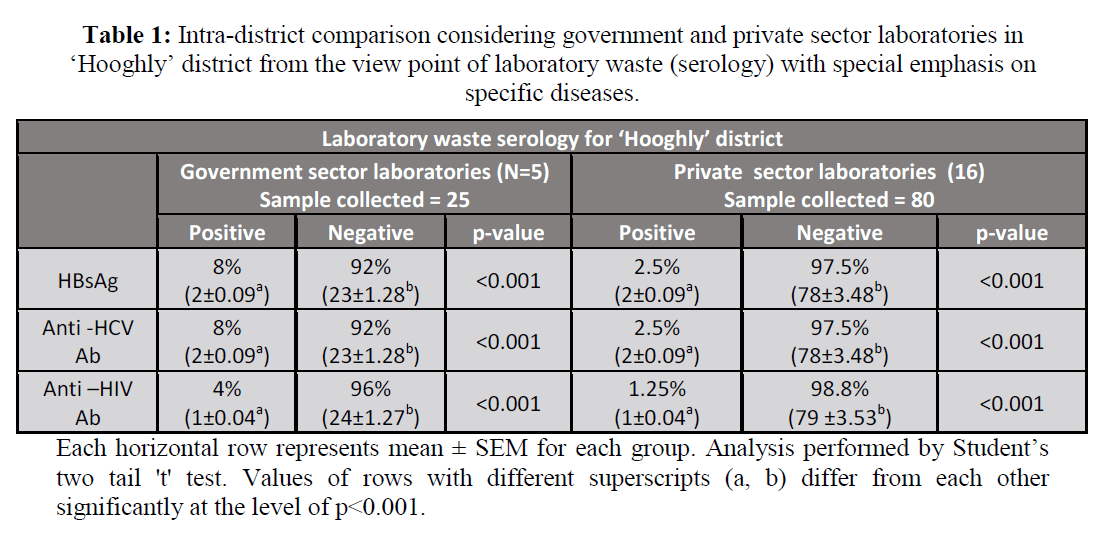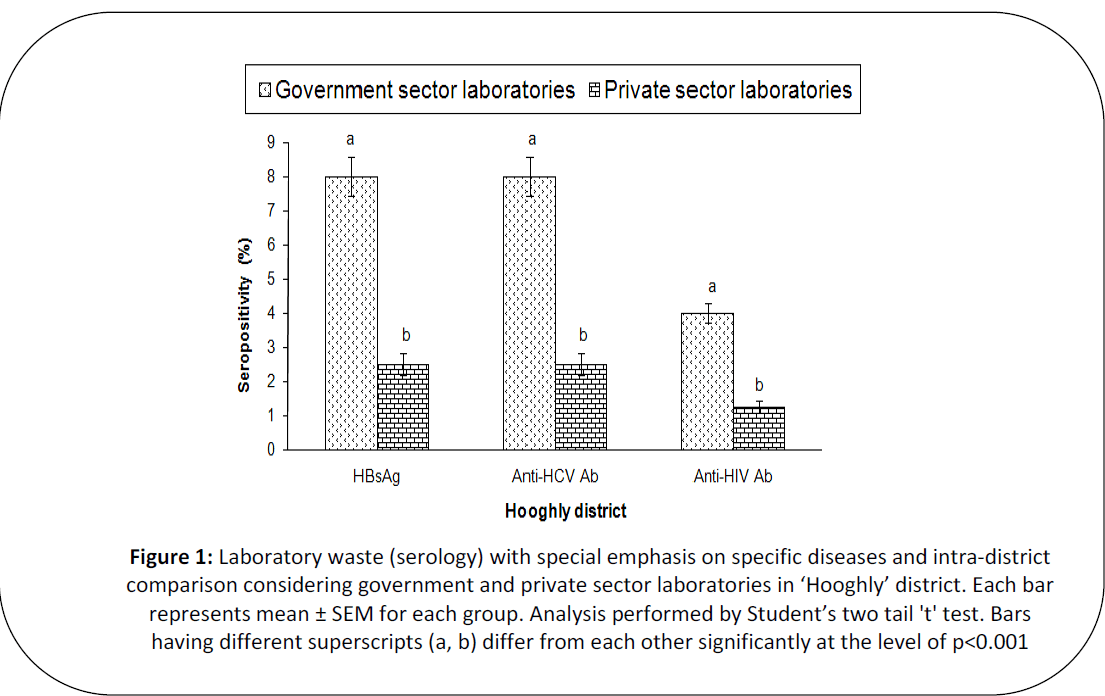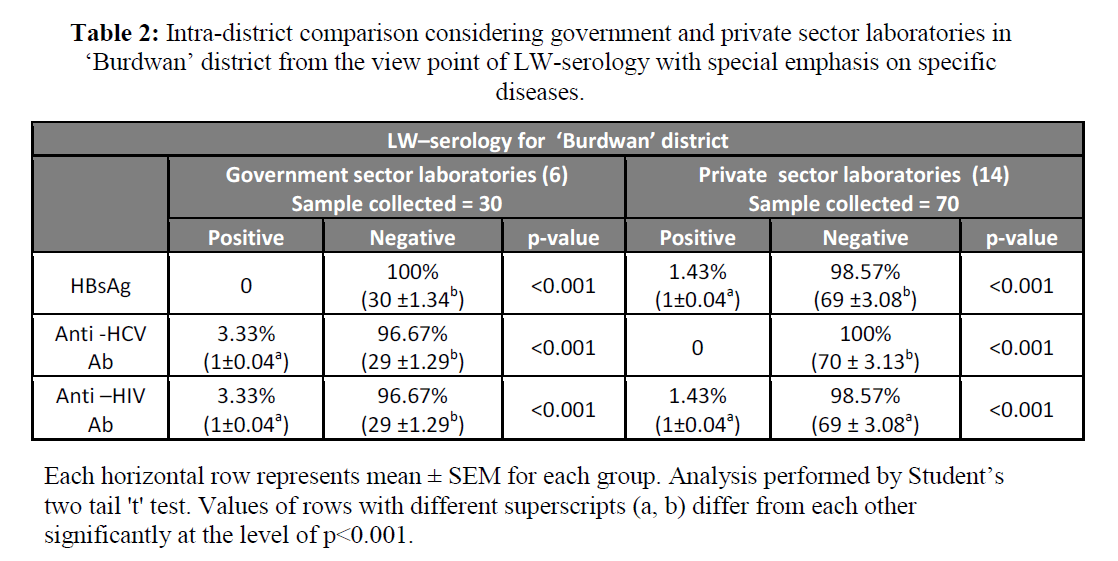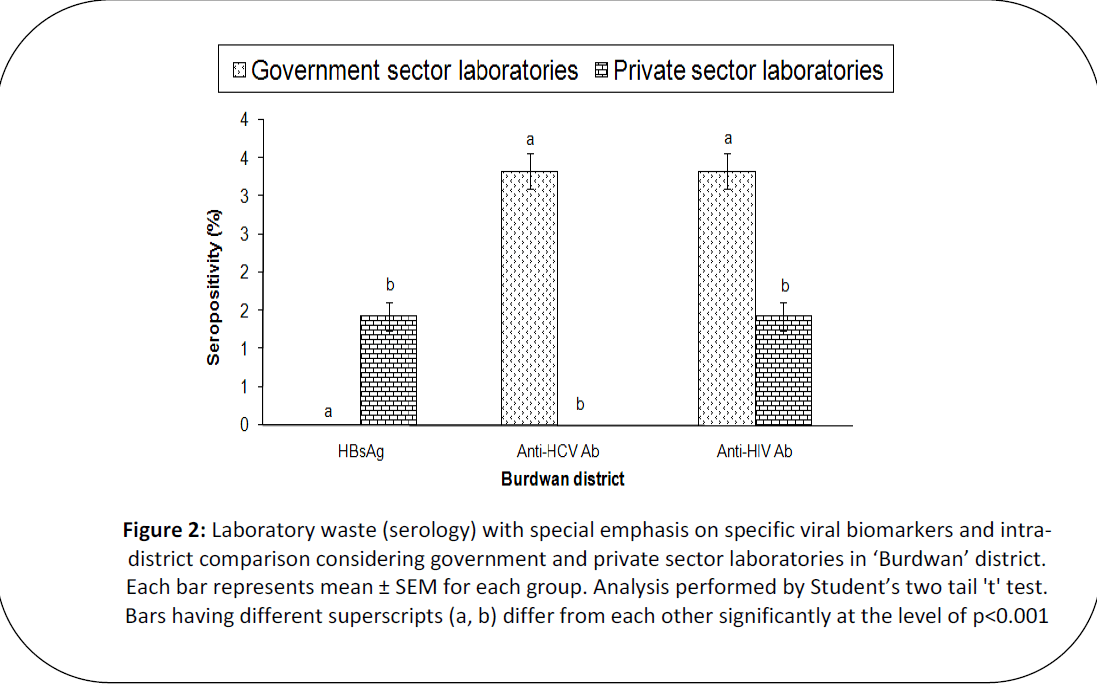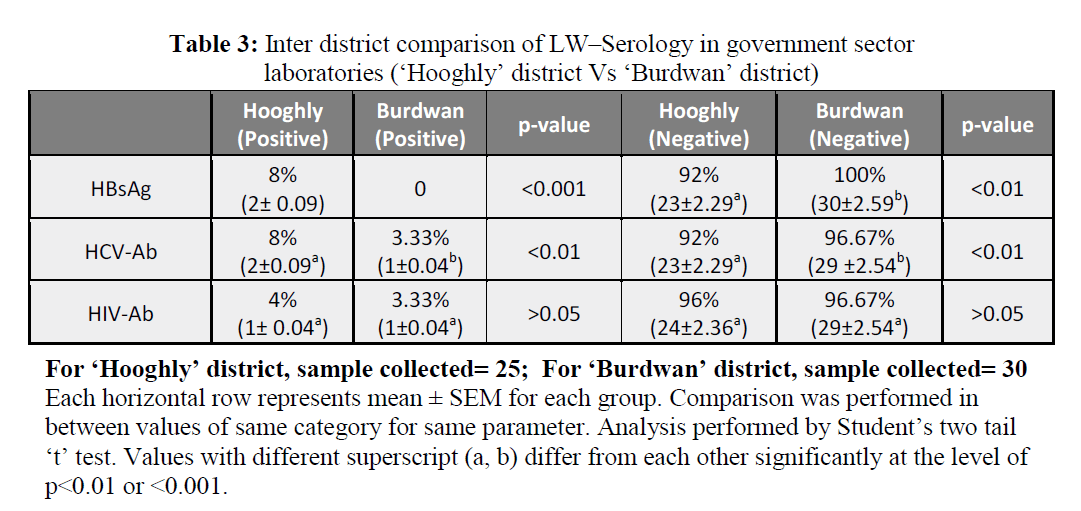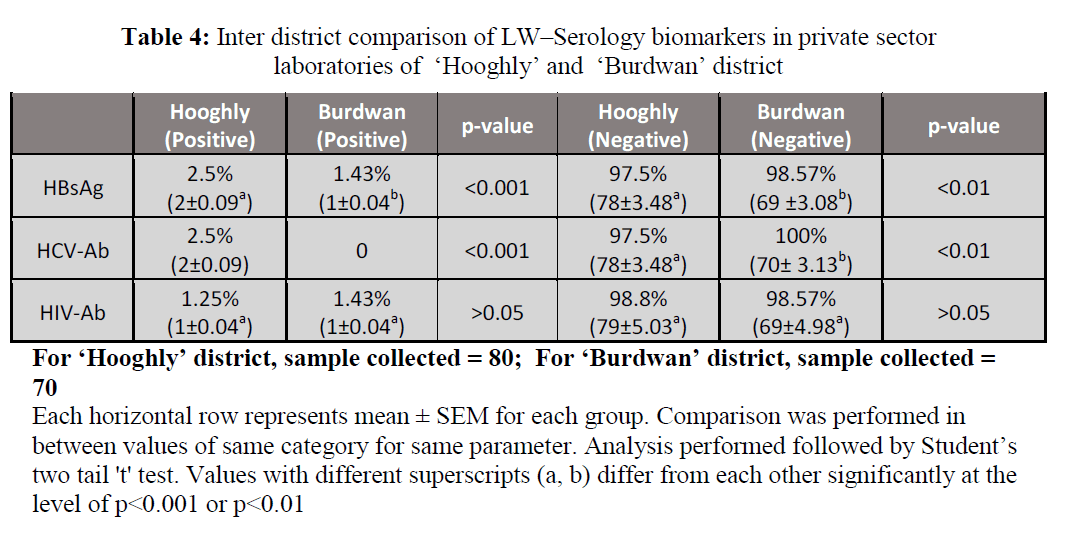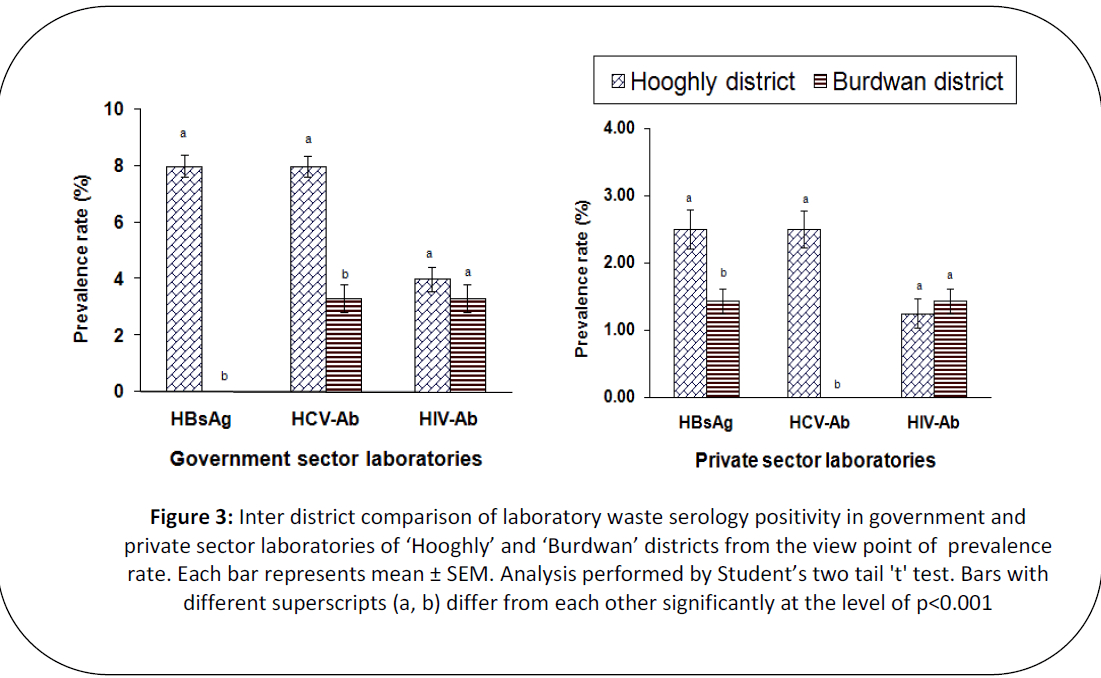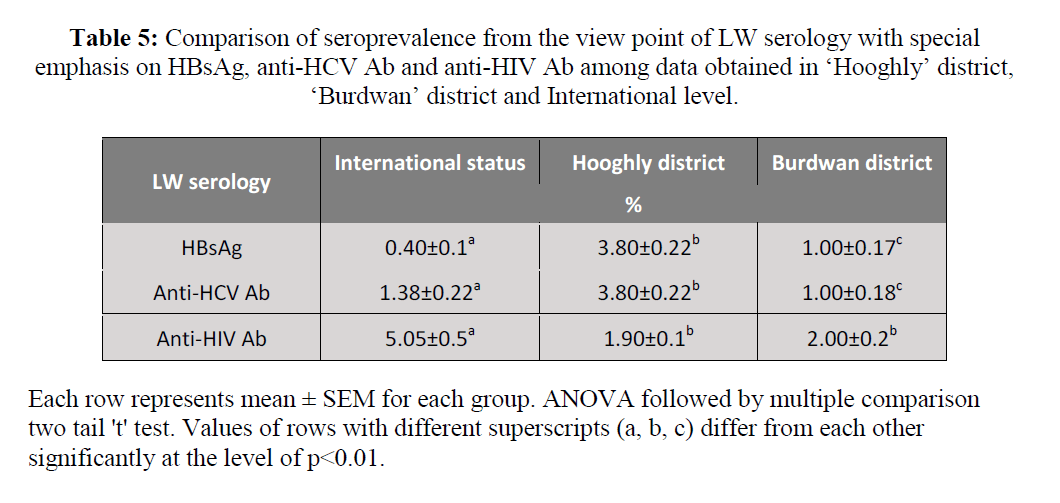Baladev Das 1,4, Raja Ray2, Kausik Chatterjee 1,4, Aparajita Das1, Ashok Kumar Saha3 and Debidas Ghosh*4
1Sevayatan School of Medical Technology (West Bengal University of Health Sciences and State Medical Faculty of West Bengal), Singur – 712 409, India
2Dept. of Microbiology, Institute of Post Graduate Medical Education & Research Kolkata-700020, West Bengal
3Dept. of Biochemistry, North Bengal Medical College and Hospital, Siliguri-734 012
4 Dept. of Bio-Medical Laboratory Science & Management with Clinical Nutrition and Dietetics, (UGC Innovative Programme Funded Department) Vidyasagar University, Midnapore-721102
- *Corresponding Author:
- Debidas Ghosh
Dept. of Bio-Medical Laboratory Science & Management with Clinical Nutrition and Dietetics
(UGC Innovative Programme Funded Department) Vidyasagar University
Midnapore-721102
E-mail: debidas_ghosh@yahoo.co.in
Keywords
Bio Medical Waste, Laboratory waste Disposal, ‘Hooghly’ and ‘Burdwan’ districts, HBsAg, Hepatitis C, HIV.
Introduction
Probability of community pollution
from the laboratory waste, especially the
blood samples collected in a clinical
laboratory for testing was analysed in our
study. As we know all the blood samples are
supposed to be potentially infectious with
viruses like ‘Human Immunodeficiency
Virus (HIV)’, ‘Hepatitis–B (HBV)’ and
‘Hepatitis-C (HCV)’ for which proper biosafety
procedure should be strictly followed
during its collection, handling and disposal [1].
An untreated contaminated sample of blood
used in the laboratory would be of great risk
to others who handle it further. For clinical
laboratories biological samples may be a
source of blood borne viral diseases among
the Bio Medical Waste (BMW) handlers,
scavengers who are used to nurture with
these without sufficient knowledge or
training for personal and environmental
protection [2]. Chances of community acquired
viral infections for HIV, HBV and HCV
from the potential hazardous laboratory
waste to be considered.
According to ‘Biomedical Waste
(Management and Handling) Rules, 1998 of
India’ [3] ‘Biomedical Waste (BMW)’ means
‘Any solid, fluid or liquid waste including
its containers and any intermediated product
which is generated during the diagnosis,
treatment or immunization of human beings
or animals or in research activities
pertaining thereto or in the production or
testing of biological and includes the
categories for same’. Majority (75-90%) of
waste produced by the healthcare providers
is non-risk and it is estimated that the
remaining (10-25%) of health care waste
regarded as hazardous which is potential for
creating a variety of health problems [4].
Biomedical waste collection and their proper
disposal have significant effect for both the
medical and general communities. Among
all health problems, there is a particular
concern with ‘HIV/AIDS’, ‘Hepatitis-B’ and
‘Hepatitis-C’ for which there is a strong
evidence of transmission through healthcare
waste. The ‘BMW’ rule is related to all those who generate, collect, receive, store,
transport, treat, dispose or handle ‘BMW’ in
any manner and to any institution that
produces ‘BMW’. The biomedical waste
should be separated out at source into colour
coded bags or containers and its collection
as well as proper disposal should come with
significant importance for both medical
personnel and general community [5].
It is estimated that annually about
0.33 million tonnes of hospital waste is
generated in India and the waste generation
rate ranges from 0.5-2.0 Kg/Bed/Day [1].
Effective management of biomedical waste
is not a legal necessity but also
responsibility to community. The purpose of
biomedical waste management is mainly to
reduce waste generation as well as to
guarantee its well-organized collection,
management and safe disposal in such a way
which ensures control of infection and
improves safety for employees working in
this system. For this a cognisant,
harmonized and cooperative efforts has to be
made from physicians to word boys. Based
on this background this study was designed
to obtain the prevalence rate of community
contamination through untreated, waste
blood samples collected for testing in the
laboratory in two said districts. Considering
the severity of blood borne infections three
specific viral markers like serum for anti
HIV antibody, serum for anti HCV antibody
and serum for HBsAg were studied with the
supplied used up, discarded blood samples.
Materials and Methods
The cross-sectional study [6] was
followed for this experiment during the
period of 2007 to 2012, which included
randomly selected 21 laboratories (5
government sector laboratories and 16
private sector laboratories) from ‘Hooghly’
district and 20 laboratories (6 government
sector laboratories + 14 private sector
laboratories) from ‘Burdwan’ district. The data regarding government and private
registered laboratories were taken from the
‘Directory of Medical Institutions–West
Bengal 2004’ and from the records of the
office of ‘Chief Medical Officer of Health’
(CMOH), ‘Hooghly’ and ‘Burdwan’. An
ethical clearance certificate was issued by
‘The Principal and Chairman, Institutional
Ethics Committee, Medical College &
Hospital’, Kolkata, Vide Memo No.-
5105/1(2) dated 08.12.2006 for conducting
the research work. Ethical clearance
certificate was also obtained from
‘Institutional Ethics Committee, ‘Vidyasagar
University’, Midnapore, Vide Memo No.-
IEC/4/2/15 Dt. 19.6.15.
Study protocol was explained and
written informed consent was taken in the
pre-standardized format from the authorities
of selected laboratories. The laboratory staff
collected blood samples from the patients
having different age limits and of both sexes
suffering from different diseases came to the
laboratories with doctor’s prescription and
advice for necessary laboratory
investigations. According to their need
laboratory staff performed the necessary
laboratory tests to generate reports. The
laboratory staff delivered us the used up
blood samples without adding any
disinfectant which were supposed to be
disposed. The collected samples by the
investigator were tested for various
diagnostic tests except for HIV antibody,
Hepatitis B surface antigen & Hepatitis C
antibody as the patients were not advised for
such test items. Collections of suitable
specimens were done randomly. The
collected samples were brought to our
laboratory & processed further following the
standard methods. Inclusion & exclusion
criteria for the patients were not stipulated in
our study protocol. No such data was
maintained by us.
Five (5) blood samples from each
laboratory were collected with prior consent of the laboratory authority. The provided
samples were kept for disposal and provided
prior to undergo any decontamination
technique or treatment for disposal of
laboratory waste. After collecting the
samples those were brought to our
investigating laboratory. The sera were
collected after centrifugation at 3000 rpm
for 10 minutes. The separated sera were
tested for the specified three parameters of
viral bio-markers using three different
immunochromatography-based test kits. The
phase included the tests for three biomarkers
of blood: serum for anti HIV antibody
(n=205); serum for anti HCV antibody
(n=205) and serum for HBsAg (n=205).
Serum for anti HIV-1 and HIV-2 antibodies
was detected using test kit, ‘Tri-Dot’ of
Diagnostic Enterprise, India [7]. Serum for
‘Hepatitis-B’ surface antigen (HBsAg) was
detected using kit of Orchid Biomedical
(Virucheck) [8]. Serum for anti ‘Hepatitis-C’
virus (HCV) antibody was detected using
test kit ‘Signal HCV’ supplied by Span
Diagnostic Limited, India [9]. Baseline data
were collected using laboratory analysis of
samples, results obtained were analyzed and
compared for significant difference between
experimental groups using ANOVA
followed by multiple comparison two-tail ‘t’
test using standard statistical softwares
(Statistica, Ver-6.0; Origin Lab, Ver-8.0;
MS Excel, Ver-07). Test results may reflect
the chances of community pollution if and
when the samples remained untreated and
not properly disposed off. Intra and inter
district comparison were made with the data
available and represented in tabular or
graphical format to obtain any new finding.
Results
Serological findings of samples from
laboratory waste revealed that in ‘Hooghly’
district out of total 25 samples collected;
HBsAg, anti-HCV antibody and anti-HIV
antibody were found reactive for 8% (2), 8% (2) and 4% (1) respectively for the
government sector. For the private
laboratory wastes, 2.5% (2), 2.5% (2) and
1.25% (1) samples confirmed positivity for
HBsAg, anti-HCV antibody and anti-HIV
antibody respectively (Table 1, Figure1).
Table 1: Intra-district comparison considering government and private sector laboratories in
‘Hooghly’ district from the view point of laboratory waste (serology) with special emphasis on
specific diseases.
Figure 1: Laboratory waste (serology) with special emphasis on specific diseases and intra-district
comparison considering government and private sector laboratories in ‘Hooghly’ district. Each bar
represents mean ± SEM for each group. Analysis performed by Student’s two tail 't' test. Bars
having different superscripts (a, b) differ from each other significantly at the level of p<0.001
For ‘Burdwan’ district, in
government sector existence for HBsAg was
found nil (0%), where as 3.33% (1) positive
cases were found for both of the anti-HCV
antibody and 3.33% (1) for the anti-HIV
antibody out of total 30 laboratory waste
samples. Out of total 70 collected samples
from private laboratories, 1.43% (1) samples
with anti-HCV antibody and 1.43% (1)
sample with anti-HIV antibody were found
reactive. Where as the positivity for HBsAg
antibody was found nil (0%) (Table 2,
Figure 2).
Table 2: Intra-district comparison considering government and private sector laboratories in
‘Burdwan’ district from the view point of LW-serology with special emphasis on specific
diseases.
Figure 2: Laboratory waste (serology) with special emphasis on specific viral biomarkers and intradistrict
comparison considering government and private sector laboratories in ‘Burdwan’ district.
Each bar represents mean ± SEM for each group. Analysis performed by Student’s two tail 't' test.
Bars having different superscripts (a, b) differ from each other significantly at the level of p <0.001
Laboratory waste serology positive
cases were higher in number in government
sector laboratories of ‘Hooghly’ district than
in ‘Burdwan’ district for all the test
parameters like HBsAg, anti-HCV antibody
and anti HIV antibody. Significant
differences were observed in case of HBsAg
and HCV antibody positivity. Only in case
of comparison for HIV parameter
insignificant (p>0.05) difference was
observed (Table 3 and Figure 3).
Table 3: Inter district comparison of LW–Serology in government sector
laboratories (‘Hooghly’ district Vs ‘Burdwan’ district)
Relatively higher positive cases were
found in private sector laboratories of
‘Hooghly’ district for each parameter of
HBsAg, anti HCV antibody and anti HIV
antibody. In private sector laboratories of
‘Burdwan’ district zero positivity was
observed for HCV parameter (Table 4 and Figure 3).
Table 4: Inter district comparison of LW–Serology biomarkers in private sector
laboratories of ‘Hooghly’ and ‘Burdwan’ district
Figure 3: Inter district comparison of laboratory waste serology positivity in government and
private sector laboratories of ‘Hooghly’ and ‘Burdwan’ districts from the view point of prevalence
rate. Each bar represents mean ± SEM. Analysis performed by Student’s two tail 't' test. Bars with
different superscripts (a, b) differ from each other significantly at the level of p<0.001
In case of LW-HBsAg study the
highest prevalence rate (3.80%) obtained in
‘Hooghly’ district which was followed by
‘Burdwan’ district (1%) and international
data (0.40%) [10]. For anti-HCV antibody, it
was found positive for 3.80% samples in
‘Hooghly’ district and 1% for ‘Burdwan’
district which was significantly (p<0.001) different from the international status
(1.38%) [10]. Existence of anti-HIV antibody
was found with significantly (p<0.01) higher
values in international condition (5.05%) in
respect of the results obtained from
‘Hooghly’ district (1.90%) and ‘Burdwan’
district (2%). (Table 5)
Table 5: Comparison of seroprevalence from the view point of LW serology with special
emphasis on HBsAg, anti-HCV Ab and anti-HIV Ab among data obtained in ‘Hooghly’ district,
‘Burdwan’ district and International level.
Discussion
Laboratory waste serological
findings in ‘Hooghly’ district revealed the
higher prevalence rate in government sector
laboratories in all three parameters than in
private sector. This scenario is also found
except for HBsAg parameter in case of
‘Burdwan’ district LW-serology. The result
in government sector may reflect the
dependence of common ailing people on the
government sector laboratories for their
diagnosis and treatment. Majority of them
may come from lower income group of the
society and their life style and health
awareness level might be inadequate in
respect of these infectious diseases.
The results favoured that
unknowingly the laboratory workers if
handle highly infectious blood samples
which were collected and underwent various
laboratory procedures would raise the
chances of environment pollution [11- 13]. For
prevention of chances of migration of
pollutants from laboratory to community
demands the adequate knowledge of biosafety
in laboratory as well as the proper
disposal technique [14,15]. Unless proper
application of inactivation procedures prior
to disposal of the used up laboratory
specimen there was a great chance of
environmental pollution2. Risks of
community acquired infections were also
there, where in-house waste management
system was undertaken. In such institution
inactivation procedure prior to disposal of
the laboratory specimen should be
maintained strictly.
To combat the chances of
environmental pollution with these
infectious diseases from the contaminated
laboratory wastes especially for the handlers
of the infected materials including the
scavengers, street beggars immunization
programme should be implemented for such
viral diseases, if possible [16-18]. Cost effective
application of 2-5% sodium hypochlorite
solution into the blood sample containers
after day to day laboratory works is
suggested in this concern. Prohibition of
dumping of used blood samples in the
common municipal garbage discarding area
without prior decontamination is strictly
recommended. Stringent follow up of proper
laboratory standard operation procedure
(SOP) for bio-safety in laboratory and
disposal of laboratory wastes is essential [19].
The laboratory authorities should maintain
these which would be supervised by the
regulatory bodies [20, 21]. Training programme
at regular interval for the laboratory
personnel as well as workers involved with
disposal procedure may be of immense
effective to control this problem [22, 23].
Laboratory waste serology in government
sector showed higher positivity than private
sector laboratories in ‘Burdwan’ district for
‘HCV’ and ‘HIV’ parameters, where as
‘HBsAg’ positivity was higher in private
sector laboratories in the said district (Table
1 and 2). Higher positivity of the laboratory
waste serology suggested more prevalence
rate of infections viruses among the patients
attended government sector laboratories in
both the districts. It indicated that perhaps
the general public with poor socio-economic
standard usually attended the government
hospitals for free treatment. Primarily they
were habituated to avoid the private health
institutes for payment of fees.
Without any discrimination of
government or private sector all biological
samples to be received for laboratory
analysis should be treated as potentially highly infectious in respect of the concerned
viral parameters. Considering the
importance of morbidity and mortality of the
diseases laboratories in all sectors should
follow the stringent methods of laboratory
bio-safety and waste disposal. Chances of
viral infections among the waste
management staff and scavengers, engaged
to collect the recyclable materials from
wastes. Hence, procedures for inactivation
or decontamination of the laboratory wastes
should be strictly followed for control and
prevention of infection from laboratory
wastes. LW–serology revealed higher
prevalence of ‘Hepatitis B’ and ‘Hepatitis C’
infected ‘BMW’ in our country, which
indicated less awareness and knowledge
about the diseases and their mode of
transmission among the general
population [24]. Whereas the higher prevalence
of ‘HIV’ infected samples were predominated
in the international scenario that
might be resulted from the life style of the
people of developed countries [25]. Chances of
environmental pollution could be minimized
following the practice of ‘BMW’
management procedures and rules
properly [26]. BMW like biological samples,
infected materials and cultures of
microorganisms should be inactivated prior
to their disposal and the chances of
environmental pollution could be
minimized. Automation is major steps may
be of immense help in this respect [27,28].
Conclusion
Chances of spreading of ‘Hepatitis
B’, ‘Hepatitis C’ and ‘HIV’ would be
initiated through the laboratory waste blood
samples. More positive samples were found
in ‘Hooghly’ district indicated the greater
chances of infection from the laboratoryy
wastes if remain untreated and not-handled
properly. Those potentially infectious
biological samples were suggested as
responsible for environmental pollution. It may contaminate directly other articles like,
laboratory furniture, containers etc. from
where during transport of the laboratory
wastes to surrounding community may get
the viral infections through skin abrasion,
injury cut etc. Disposal of laboratory wastes
can be managed under any suitable
department of the state government which
would be cost effective for the small
laboratories in private sector. Alternatively,
substitute own/in-house arrangement system
for scientific disposal of laboratory waste to
be encouraged where in rural areas the
agency provider are less interested to collect
the wastes regularly.
Acknowledgements
District health authorities of Hooghly
& Burdwan district; laboratory staff &
authority of the included laboratories of two
districts; Principal, Medical College and
Hospital, Kolkata; Members of Department
of Microbiology, Institute of Post Graduate
Medical Education & Research (S.S.K.M.
Hospital), Kolkata; Members of Department
of Microbiology, Sevayatan School of
Medical Technology, Singur; Members of
Department of Bio-Medical Laboratory
Sciences & Management, Vidyasagar
University, Midnapore are highly
acknowledged.
References
- Patil, N., Berno, A.J., Hinds, D.A., Barrett, W.A., Doshi, J.M., Hacker,
C.R., Kautzer, C.R., Lee, D.H.,
Marjoribanks, C. and McDonough, D.P.
Blocks of limited haplotype diversity
revealed by high-resolution scanning of
human chromosome 21. Science. 2001;
294: 1719–1723.
- Leanne, M. Australian Standard 2243; Safety in Laboratories. Risk
management office, University of
Sydney, 2001, Pp.1-39.
- Sharma, A.K. Biomedical waste (Management and handling) Rules,
Bhupal, Subidha Law house, 1998, Pp.
1-73.
- WHO (World Health Organization). Prüss, A., Giroult, E. and Rushbrook,
P.(Eds.); Safe management of waste
from healthcare activities, Geneva, 1999,
Pp. 1-256.
- CPCB (Central Pollution Control Board).Environmental standard and
guidelines for management of hospital
waste, (CPCB). Ministry of Environment
and forestry, New Delhi, 1996, Pp. 1-
263.
- Naveed, S., Hameed, A., and Jaffery, W.Z. Awareness about Inflammatory
Bowel Disease a Survey Based Study. British Journal of Research.2004; 1(3):
134-140.
- Sudha, T., Teja, V.D., Gopal, M., Rajesh, M. and Lakshmi V. Comparative
evaluation of TRI-DOT Rapid HIV test
with fourth-generation ELISA for the
detection of human immunodeficiency
virus. Clinical Microbiology and Infection. 2005; 11:850–852.
- Maity, S., Nandi, S., Biswas, S., Sadhukhan, S.K. and Saha, M.K.
Performance and diagnostic usefulness
of commercially available enzyme
linked immunosorbent assay and rapid
kits for detection of HIV, HBV and
HCV in India. Virology Journal. 2012;
9: 290-299.
- Pincus, M.R., Tierno, P., Dufour, D.R. In: McPhetson, R.A. & Pincus, R.M.
(eds), Henry’s clinical diagnosis and
management by laboratory methods, 21st
Ed. Elsevier, New Delhi; 2007, Pp. 272-
273.
- Strain, B.A. and Groschel, D.H.M. Laboratory safety and infectious waste
management. In: Murray, P.R., Baron,
E.J., Pfaller, M.A., Tenover, F.C., &
Yolken, R.H. (eds), Manual of Clinical Microbiology, 6th Ed. American Society
for Microbiology, Washington, D.C.;
1995, Pp.75–85.
- Pklay, M. Clinical laboratory safety, biohazard surveillance and infection
control in clinical laboratory medicine.
In: Richard, C.T. (ed.), Mosly Year
Book Inclusion 1992; 2: 13-24.
- Ejilemele, A.A. and Ojule, A.C. Health and Safety in Clinical Laboratories in
developing countries: safety
considerations. Nigerian Journal of Medicine. 2004; 13:182-188.
- Kausar, A., Akram, M., Shoaib, M., Mehmood, R.T., Abbasi, M.N.,
Muhammad, A., Aziz, H., and Asad,
M.J. Isolation and Identification of UTI
Causing Agents and Frequency of ESBL
(Extended Spectrum Beta Lactamase) in
Pakistan. American Journal of Phytomedicine and Clinical Therapeutics 2014; 2(8): 963-975.
- Sharma, R., Rasania, S.K., Verma, A., and Saudan, P. Study of prevalence and
response to needle stick injuries among
health care workers in a tertiary care
hospital in Delhi, India. Indian Journal of Community Medicine. 2010; 35: 74-
77.
- Manyele, S. V. and Lyasenga, T. J. Factors affecting medical waste
management in low- level health
facilities in Tanzania. African Journal of Environmental Science and Technology 2010; 4(5):304-318.
- Webster, G.J. Molecular epidemiology of a large outbreak of hepatitis B linked
to autohaemotherapy. Lancet 2000; 356:
379–384.
- Shaheen, S., Nighat, N., and Majid, H.Q. Knowledge regarding hepatitis B among
EPI vaccinators working in district sout,
Karachi. Pakistan Journal of Medical Science 2007; 23:538-541.
- Samuel, S.O., Aderibigbe, S.A., Salami, T. and Babatunde, O.A. Health workers’ knowledge, attitude and behaviour
towards hepatitis B infection in Southern
Nigeria. International Journal of Medical Science. 2009; 1:418-424
- Saleem, T., Khalid, U., Ishaque, S. and Zafar, A. Knowledge, attitudes and
practices of medical students regarding
needle stick injuries. Journal of Pakistan Medical Association 2010; 60:151-156.
- Dienstag, J.L. and Ryan. D.M. Occupational exposures to hepatitis B
virus in hospital personnel: infection or
immunity? American Journal of Epidemiology 1982; 115:26–39.
- Vaz, K., McGrowder, D., Alexander- Lindo, R., Gordon, L., Brown, P. and
Irving, R. Knowledge, awareness and
compliance with universal precautions
among health care workers at the
University Hospital of the West Indies,
Jamaica. International Journal of Occupational Environmental Medicine. 2010; 1:171‑181.
- NCCLS (National Committee for Clinical Laboratory Standards).
Protection of laboratory workers from
infectious disease transmitted by blood,
body fluids and tissue. Document M 29-
T2. National Committee for Clinical
Laboratory Standards, Villanova, 1991;
Pp.1-64.
- DHHS (Department of Health and Human Services, U.S.). Bio-safety in
micro-biological and biomedical
laboratories. HHS publication (CDC). U.S. Government Printing Office,
Washington, D.C., 1993; Pp. 93-839.
- Lakshminarayanan, S. Role of government in public health: Current
scenario in India and future scope. Journal of Family and Community Medicine. 2011; 18: 26–30.
- Olukanni, D.O., Azuh, D.E., Toogun, T. O. and Okorie, U.E. Medical waste
management practices among selected
health-care facilities in Nigeria: A case
study. Scientific Research and Essays 2014; 9:431-439.
- Boyce, J.M., Potter-Bynoe, G., Chenevert, C. and King, T.
Environmental contamination due to
methicillin-resistant Staphylococcus aureus: possible infection control
implications. Infection Control Hospital Epidemiology. 1997; 18: 622-627.
- Strain, B.A. and Groschel, D.H.M. Laboratory safety and infectious waste
management. In: Murray, P.R., Baron,
E.J., Pfaller, M.A., Tenover, F.C.&
Yolken, R.H. (eds), Manual of Clinical
Microbiology, 6th Ed. American Society
for Microbiology, Washington, D.C.;
1995, Pp.75–85.
- Thompson, S.C., Boughton, C.R. and Dore, G.J. Blood-borne viruses and their
survival in the environment: is public
concern about community needlestick
exposures justified? Australian and New Zealand Journal of Public Health. 2003;
27: 602-607.

